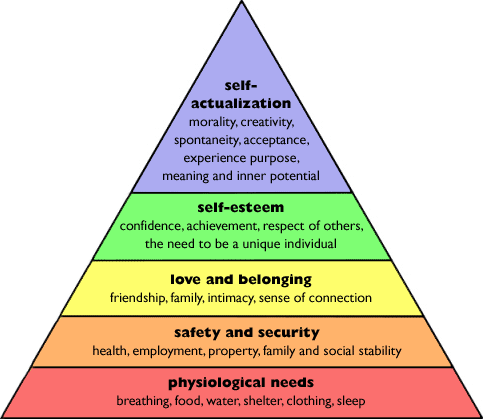Motivation and engagement
Like the national economy, human motivation is a topic that people know is important, continuously discuss, and would like to predict. We want to know why people do what they do. But just as tomorrow’s inflationary trend seems beyond our influence and understanding, so too do the causes of human behaviour evade any simple explanation or prescription.
Wlodkowski & Ginsberg, 2017
Motivation is complex with many different theories informing various aspects of it. In a learning situation, motivation can be impacted by any number of things, including:
- Needs
- Interests
- Values
- Attitudes
- Incentives
- Fears
Needs: Maslow’s hierarchy of needs offers one theory of motivation. Maslow proposes that in order to strive for higher level needs (i.e. esteem and cognitive), lower level needs (physical, safety) must be met. Learners who are physically uncomfortable or who feel unsafe (threatened) are not likely to be able to focus on learning.
Fears: Many fears affect motivation, including fears of failure, rejection, reactions from others, success, pain, etc. Fear is a very difficult psychological phenomenon, so as teachers our goal is to create a learning environment that is as safe, positive, inclusive, and success oriented as possible
Consider reflecting upon how you can enhance motivation and engagement:
- What might be affecting your students’ motivation?
- How could various aspects of your instruction enhance motivation – learning outcomes, course topics, teaching strategies, classroom environment, assessment methods?
Ideas to enhance motivation and engagement
From a teaching perspective, it is important to focus on the things that you (the teacher) can do something about. Strive to engage more students more of the time, rather than all students, all the time. For the most part, sound teaching strategies will improve motivation in cases that are within the teacher’s “sphere of influence”. As Wlodkowski points out, “every instructional plan also need to be a motivational plan” (p. 23) In this section we identify a number of strategies using John Keller’s ARCS model for motivational learning design.
A – Attention; R – Relevance; C – Confidence; S – Satisfaction
Attention:
- Tie learning in your course to the students’ motivations. Take time early in the course to find out about motivations for being in college and for taking your course.
- Incorporate fun, current, and/or everyday examples for course concepts.
- Design instruction using a variety of strategies to appeal to learner diversity
- Focus students in their reading and note-taking using charts, visual organizers, outlines, etc.
Relevance:
- Use a variety of Classroom Assessment Techniques to highlight what students already know related to topics and then connect new information to prior learning.
- Build an interactive learning community that involves everyone in the learning process.
- Give students options in major assignments whenever possible
- Link learning outcomes, classroom activities, and assessment.
Confidence:
- Be firm, friendly, fair, and consistent. Set clear and reasonable expectations.
- Give students specific, constructive feedback early, allowing more opportunity for success. Incorporate formative assessments (assessments for learning)
- Use a variety of strategies to “structure learning for success” – scaffolding, modeling, opportunities for guided practice, coaching.
- Get students actively involved in the learning process. Visit the CTL Active Learning page for additional strategies.
- Help students link achievement to effort and effective learning strategies. Give students opportunities to share and/or practice a variety of learning strategies.
Satisfaction:
- Design relevant, achievable, and authentic learning tasks and assignments.
- Provide several opportunities to demonstrate learning of key skills.
- Build in the development of essential skills (critical thinking, communicating, etc).
References
Wlodkowski, R. J., & Ginsberg, M. B. (2017). Enhancing adult motivation to learn: A comprehensive guide for teaching all adults. John Wiley & Sons.
